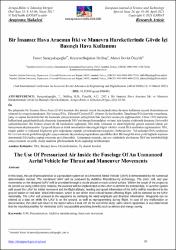Bir İnsansız Hava Aracının İtki ve Manevra Hareketlerinde Gövde İçi Basınçlı Hava Kullanımı
Abstract
Bu çalışmada bir İnsansız Hava Aracı (UAV) üzerinde itki sistemi olarak basınçlandırılmış havanın kullanımı sayısal determinasyon
yöntemi ile ortaya konmaktadır. Söz konusu İHA, Eklemeli Üretim (EÜ) yöntemi ile üretilecektir. Tasarlanan İHA üzerinde yunuslama,
yatış ve sapma hareketleri her bir kumanda yüzeyi üzerinde yerleştirilen lüle (nozzle) vasıtasıyla sağlanacaktır. Ultem 1010 malzeme
kullanılarak gerçekleştirilecek olan proje kapsamında İHA’nın istenen kumandaları vermesi için üzerine elektronik donanım (Aviyonik)
yerleştirilecektir. Bir fırlatıcı sistem ile ilk hareketinin sağlandığı İHA irtifa, istikamet ve sürat bilgilerini gerçek zamanlı olarak yer
istasyonuna akyataracaktır. Uçuşu etkileyen en kritik unsurlardan olan rüzgâr bilgisi vektörel olarak İHA tarafından algılanacaktır. İHA,
rüzgâr şiddet ve istikamet bilgilerine göre doğrulama yaparak yol noktalarına (waypoint) ilerleyecektir. Yol noktaları İHA yerdeyken
bir veri seti olarak girilebileceği gibi, uçuş esnasında da yeniden programlama yapılabilecektir. Herhangi bir arıza ya da bağlantı kopması
durumunda İHA kalkış yaptığı istasyona geri dönecektir. Çalışmanın sonunda, mevcut imkânlarla söz konusu İHA’nın üretilebelirliği
ortaya konarak sessizlik, enerji tasarrufu gibi konularda fayda sağladığı belirlenmiştir. In this study, the use of pressurized air as a propulsion system on an Unmanned Aerial Vehicle (UAV) is demonstrated by the numerical
determination method. The mentioned UAV will be produced by Additive Manufacturing technology. The pitch, roll, and yaw
movements on the designed UAV will be provided through a nozzle placed on each control surface. Within the scope of the project to
be carried out using Ultem 1010 material, the avionics will be implemented on the UAV to perform the entered data. A launcher system
will propel the UAV for initial movement and the flight altitude, heading and speed information of the UAV will be transferred to the
ground station in real-time. Wind information, which is one of the most critical factors affecting flight, will be detected by the UAV
vectorially. The UAV will proceed to the waypoints by verifying the wind amplitude and direction information. Waypoints can be
entered as a data set while the UAV is on the ground, as well as reprogramming during flight. In case of any malfunction or
disconnection, the UAV will return to the station where it took off. At the end of the study, with current capabilities, it was determined
that the manufacturability for mentioned UAV was possible providing benefits such as silence and energy saving
Issue
Özel Sayı 24, Nisan 2021Collections
The following license files are associated with this item:


















